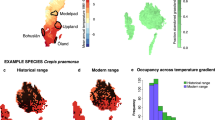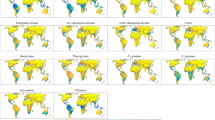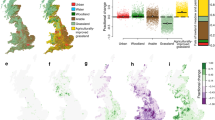Abstract
Current conservation policy has been shaped by the expectation that, for many species, places with suitable climate will lie outside their current range, thus leading to predictions of numerous extinctions. Here we show that the magnitude of range shifts is often overestimated as climate data used do not reflect the microclimatic conditions that many organisms experience. We model the historic (1977–1995) distributions of 244 heathland and grassland plant taxa using both macro- and microclimate data and project these distributions to present day (2003–2021). Whereas macroclimate models predicted major range shifts (median 14 km shift), microclimate models predicted localized shifts, generally of less than 1 km, into favourable microclimates that more closely match observed patterns of establishment and extirpation. Thus, improving protection of refugial populations within species’ existing geographic range may, for species living in environments exposed to sunlight, be more effective than assisted translocations and overhaul of protected area networks.
This is a preview of subscription content, access via your institution
Access options
Access Nature and 54 other Nature Portfolio journals
Get Nature+, our best-value online-access subscription
$29.99 / 30 days
cancel any time
Subscribe to this journal
Receive 12 print issues and online access
$209.00 per year
only $17.42 per issue
Buy this article
- Purchase on Springer Link
- Instant access to full article PDF
Prices may be subject to local taxes which are calculated during checkout




Similar content being viewed by others
Data availability
The global gridded 0.5° climate dataset is available from https://crudata.uea.ac.uk/cru/data/hrg/. The UK gridded climate dataset is available from https://www.metoffice.gov.uk/research/climate/maps-and-data/data/haduk-grid/datasets. Datasets required to generate the 100-m-resolution gridded climate dataset for the Lizard Peninsula are included with R package microclima16 available from https://github.com/ilyamaclean/microclima. Plant distribution datasets required to run the models are published online38. Forest-cover datasets are publicly available from UKCEH53 and https://land.copernicus.eu/pan-european/corine-land-cover.
Code availability
All data and code used for the analysis are available on request from the corresponding author and are published online38. The microclima16 R package is available from https://github.com/ilyamaclean/microclima.
References
Bellard, C., Bertelsmeier, C., Leadley, P., Thuiller, W. & Courchamp, F. Impacts of climate change on the future of biodiversity. Ecol. Lett. 15, 365–377 (2012).
Dawson, T. P., Jackson, S. T., House, J. I., Prentice, I. C. & Mace, G. M. Beyond predictions: biodiversity conservation in a changing climate. Science 332, 53–58 (2011).
Thomas, C. D. et al. Extinction risk from climate change. Nature 427, 145–148 (2004).
Chen, I.-C., Hill, J. K., Ohlemüller, R., Roy, D. B. & Thomas, C. D. Rapid range shifts of species associated with high levels of climate warming. Science 333, 1024–1026 (2011).
Lenoir, J. et al. Species better track climate warming in the oceans than on land. Nat. Ecol. Evol. 4, 1044–1059 (2020).
Lenoir, J. & Svenning, J. C. Climate‐related range shifts—a global multidimensional synthesis and new research directions. Ecography 38, 15–28 (2015).
Thomas, C. D. Translocation of species, climate change, and the end of trying to recreate past ecological communities. Trends Ecol. Evol. 26, 216–221 (2011).
Heller, N. E. & Zavaleta, E. S. Biodiversity management in the face of climate change: a review of 22 years of recommendations. Biol. Conserv. 142, 14–32 (2009).
Bramer, I. et al. Advances in monitoring and modelling climate at ecologically relevant scales. Adv. Ecol. Res. 58, 101–161 (2018).
Maclean, I. M. D., Bennie, J. J., Scott, A. J. & Wilson, R. J. A high-resolution model of soil and surface water conditions. Ecol. Modell. 237, 109–119 (2012).
Maclean, I. M. D., Suggitt, A. J., Wilson, R. J., Duffy, J. P. & Bennie, J. J. Fine‐scale climate change: modelling spatial variation in biologically meaningful rates of warming. Glob. Change Biol. 23, 256–268 (2017).
Potter, K. A., Arthur Woods, H. & Pincebourde, S. Microclimatic challenges in global change biology. Glob. Change Biol. 19, 2932–2939 (2013).
Trivedi, M. R., Berry, P. M., Morecroft, M. D. & Dawson, T. P. Spatial scale affects bioclimate model projections of climate change impacts on mountain plants. Glob. Change Biol. 14, 1089–1103 (2008).
Randin, C. F. et al. Climate change and plant distribution: local models predict high‐elevation persistence. Glob. Change Biol. 15, 1557–1569 (2009).
Dobrowski, S. Z. A climatic basis for microrefugia: the influence of terrain on climate. Glob. Change Biol. 17, 1022–1035 (2011).
Maclean, I. M. D., Mosedale, J. R. & Bennie, J. J. Microclima: an R package for modelling meso‐and microclimate. Methods Ecol. Evol. 10, 280–290 (2019).
Harris, I., Osborn, T. J., Jones, P. & Lister, D. Version 4 of the CRU TS monthly high-resolution gridded multivariate climate dataset. Sci. Data 7, 109 (2020).
Hollis, D., McCarthy, M., Kendon, M., Legg, T. & Simpson, I. HadUK‐Grid—a new UK dataset of gridded climate observations. Geosci. Data J. 6, 151–159 (2019).
GBIF.org. GBIF Occurrence Data Downloads historic (1977–1995): https://doi.org/10.15468/dl.38928w and recent: (2003–2021) https://doi.org/10.15468/dl.5cdeuy Accessed from R via rgbif (https://github.com/ropensci/rgbif) on 2022-07-31.
Preston, C. D., Pearman, D. & Dines, T. D. New Atlas of the British & Irish Flora (Oxford Univ. Press, 2002).
Bennallick, I. et al. Red Data Book for Cornwall and the Isles of Scilly 2nd edn (Croceago Press, 2009).
Haesen, S. et al. ForestTemp–sub‐canopy microclimate temperatures of European forests. Glob. Change Biol. 27, 6307–6319 (2021).
Blonder, B. et al. Extreme and highly heterogeneous microclimates in selectively logged tropical forests. Front. For. Glob. Change 1, 5 (2018).
Marsh, C. D. et al. Measuring and modelling microclimatic air temperature in a historically degraded tropical forest. Int. J. Biometeorol. 66, 1283–1295 (2022).
Lenoir, J., Hattab, T. & Pierre, G. Climatic microrefugia under anthropogenic climate change: implications for species redistribution. Ecography 40, 253–266 (2017).
Hickling, R. et al. The distributions of a wide range of taxonomic groups are expanding polewards. Glob. Change Biol. 12, 450–455 (2006).
Bertrand, R. et al. Changes in plant community composition lag behind climate warming in lowland forests. Nature 479, 517–520 (2011).
Bertrand, R. et al. Ecological constraints increase the climatic debt in forests. Nat. Commun. 7, 12643 (2016).
Lembrechts, J. J. & Lenoir, J. Microclimatic conditions anywhere at any time! Glob. Change Biol. 26, 337–339 (2020).
Gillingham, P., Huntley, B., Kunin, W. & Thomas, C. The effect of spatial resolution on projected responses to climate warming. Divers. Distrib. 18, 990–1000 (2012).
Araújo, M. B. et al. Standards for distribution models in biodiversity assessments. Sci. Adv. 5, eaat4858 (2019).
Araújo, M. B., Alagador, D., Cabeza, M., Nogués‐Bravo, D. & Thuiller, W. Climate change threatens European conservation areas. Ecol. Lett. 14, 484–492 (2011).
Greenwood, O., Mossman, H. L., Suggitt, A. J., Curtis, R. J. & Maclean, I. M. D. Using in situ management to conserve biodiversity under climate change. J. Appl. Ecol. 53, 885–894 (2016).
R Core Team R: A Language and Environment for Statistical Computing (R Foundation for Statistical Computing, 2022).
Kearney, M. R., Gillingham, P. K., Bramer, I., Duffy, J. P. & Maclean, I. M. D. A method for computing hourly, historical, terrain-corrected microclimate anywhere on Earth. Methods Ecol. Evol. 11, 38–43 (2020).
Kalnay, E. et al. The NCEP/NCAR 40-year reanalysis project. Bull. Am. Meteorol. Soc. 77, 437–472 (1996).
Kearney, M. R. & Porter, W. P. NicheMapR—an R package for biophysical modelling: the microclimate model. Ecography 40, 664–674 (2017).
Maclean, I. M. D. & Early R. R code and data to accompany macroclimate data over-estimate range shifts of plants in response to climate change. Zenodo https://doi.org/10.5281/zenodo.7221995 (2022).
Nychka, D., Furrer, R., Paige, J. & Sain, S. fields: Tools for Spatial Data https://doi.org/10.5065/D6W957CT (UCAR, 2015).
Hijmans, R. J., Cameron, S. E., Parra, J. L., Jones, P. G. & Jarvis, A. Very high resolution interpolated climate surfaces for global land areas. Int. J. Climatol. 25, 1965–1978 (2005).
Xu, T. & Hutchinson, M. ANUCLIM version 6.1 User Guide (Fenner School of Environment and Society, The Australian Natl Univ., 2011).
Pearson, R. G. & Dawson, T. P. Predicting the impacts of climate change on the distribution of species: are bioclimate envelope models useful? Glob. Ecol. Biogeogr. 12, 361–371 (2003).
Petitpierre, B., Broennimann, O., Kueffer, C., Daehler, C. & Guisan, A. Selecting predictors to maximize the transferability of species distribution models: lessons from cross‐continental plant invasions. Glob. Ecol. Biogeogr. 26, 275–287 (2017).
Hughes, A. C. et al. Sampling biases shape our view of the natural world. Ecography 44, 1259–1269 (2021).
Baker, D. A., Maclean, I. M. D., Goodall, M. & Gaston, K. J. Correlations between spatial sampling biases and environmental niches affect species distribution models. Glob. Ecol. Biogeogr. 31, 1038–1050 (2022).
Brown, J. L. SDM toolbox: a python‐based GIS toolkit for landscape genetic, biogeographic and species distribution model analyses. Methods Ecol. Evol. 5, 694–700 (2014).
Phillips, S. J. & Dudík, M. Modeling of species distributions with Maxent: new extensions and a comprehensive evaluation. Ecography 31, 161–175 (2008).
Hastie, T. J. & Tibshirani, R. J. Generalized Additive Models (CRC Press, 1990).
Breiman, L. Random forests. Mach. Learn. 45, 5–32 (2001).
F Dormann, C. et al. Methods to account for spatial autocorrelation in the analysis of species distributional data: a review. Ecography 30, 609–628 (2007).
Naimi, B. & Araújo, M. B. sdm: a reproducible and extensible R platform for species distribution modelling. Ecography 39, 368–375 (2016).
Büttner, G. CORINE Land Cover and Land Cover Change Products. In Land Use and Land Cover Mapping in Europe (eds Manakos, I. & Braun, M. 55–74 (Springer, 2014).
Land Cover Map 2020 (UKCEH Environmental Information Data Centre, 2020).
Di Cola, V. et al. ecospat: an R package to support spatial analyses and modeling of species niches and distributions. Ecography 40, 774–787 (2017).
Pebesma, E. & Bivand, R. Classes and methods for spatial data in R. R News 5, 9–13 (2005).
Acknowledgements
We thank K. Gaston for helpful comments. I.M.D.M. was supported by the Natural Environment Research Council (NE/L00268X/1).
Author information
Authors and Affiliations
Contributions
I.M.D.M. and E.R. conceived and designed the study. I.M.D.M. performed the numerical analysis and wrote the paper with contributions from E.R. Both authors discussed and interpreted results.
Corresponding author
Ethics declarations
Competing interests
The authors declare no competing interests.
Peer review
Peer review information
Nature Climate Change thanks Jonas Lembrechts, Jonathan Lenoir, Martin Macek and Helen Slater for their contribution to the peer review of this work.
Additional information
Publisher’s note Springer Nature remains neutral with regard to jurisdictional claims in published maps and institutional affiliations.
Extended data
Extended Data Fig. 1 Range shifts predicted using macro- and microclimate data.
Here results are shown without forest grid cells masked. Top: how far taxa would need to move in order to track climatic changes. Here the mean distances between each grid cell predicted to be occupied historically (1977–1995) and the nearest location with climatically suitable conditions under recent condition (2003–2021) is predicted using (a) 0.5° and (b) 5 km grid resolution macroclimate data and (c) 100 m grid resolution microclimate data for each of 244 plant taxa. Bottom: here the magnitude and direction of the shift in the suitability-weighted centroid of each taxa’s distribution is shown, modelled at (d) 0.5°, (e) 5 km resolution and (f) 100 m resolution.
Extended Data Fig. 2 Range shifts predicted using macro- and microclimate data (forest cells not masked).
Mean distances between each grid cell predicted to be occupied recently (2003–2021) to the nearest location with climatically suitable conditions historically (1977–1995) predicted using (a) 0.5° and (b) 5 km grid resolution macroclimate data and (c) 100 m grid resolution microclimate data for each of 244 plant taxa.
Extended Data Fig. 3 Range shifts predicted using macro- and microclimate data (additional models).
a–d, Mean distances between each grid cell predicted to be occupied historically (1977–1995) and the nearest location with climatically suitable conditions under recent condition (2003–2021). e–h, The magnitude and direction of the shift in the suitability-weighted centroid of each taxa’s distribution. a,e, Results for Erica tetralix modelled at 100 m resolution at each of 73 sites. b,f, The results for all taxa modelled at 0.5° grid resolution, but using temperature estimates for 5 cm above ground. c,g, Results for models fitted across Europe and projected to the Lizard Peninsula (temperature estimates 5 cm above ground). d,h, Results for the Lizard Peninsula using temperature estimates at the height of a standard weather station.
Extended Data Fig. 4 Suitability predicted using macro- and microclimate (forest grid cells not masked).
In (a) and (b) the relationship between the current (2003–2021) and historic (1977–1995) predicted probability of occurrence on the Lizard Peninsula is shown for all taxa, demonstrating that when microclimate (green) data are used, the relationship is shallower than when macroclimate (purple) data are used. In consequence, when modelled using microclimate data, fewer extirpations are predicted. The green and purple dashed lines are the line-of-best fit for the modelled relationship for microclimate and macroclimate respectively. In (a) macroclimate occurrence is derived from 0.5° grid resolution models and in (b) from 5 km grid resolution models. In (c) the relationship between the current (2003–2021) and historic (1977–1995) predicted probability of occurrence of Erica tetralix is shown in every grid cell with a predicted probability of occurrence >0.1 across Europe (purple) and for each 100 m grid cell with a historic record in each of 73 40 × 40 km selected focal areas (green).
Supplementary information
Supplementary Data 1
Supplementary Tables 1–8.
Rights and permissions
Springer Nature or its licensor (e.g. a society or other partner) holds exclusive rights to this article under a publishing agreement with the author(s) or other rightsholder(s); author self-archiving of the accepted manuscript version of this article is solely governed by the terms of such publishing agreement and applicable law.
About this article
Cite this article
Maclean, I.M.D., Early, R. Macroclimate data overestimate range shifts of plants in response to climate change. Nat. Clim. Chang. 13, 484–490 (2023). https://doi.org/10.1038/s41558-023-01650-3
Received:
Accepted:
Published:
Issue Date:
DOI: https://doi.org/10.1038/s41558-023-01650-3
This article is cited by
-
Mechanisms, detection and impacts of species redistributions under climate change
Nature Reviews Earth & Environment (2024)
-
Temperature and microclimate refugia use influence migratory timings of a threatened grassland bird
Movement Ecology (2023)
-
Animal-borne sensors as a biologically informed lens on a changing climate
Nature Climate Change (2023)
-
Microclimate alters the picture
Nature Climate Change (2023)
-
Patchy range retractions in response to climate change and implications for terrestrial species conservation
Landscape Ecology (2023)



